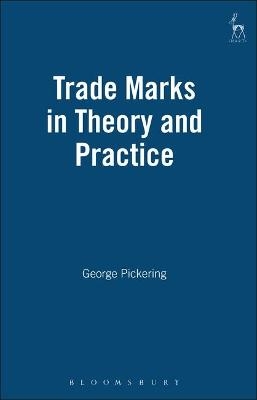
Trade Marks in Theory and Practice
Hart Publishing (Verlag)
978-1-901362-64-0 (ISBN)
This book is concerned with the nature and function of modern trademarks,a subject which has been surprisingly ignored by contemporary writers. There is a large and quite technical body of rules which regulate when people may use particular symbols in a particular way. These are the symbols which permeate everyday life, and which, from time to time, become cultural icons. There is also a large body of writing on the economic functions of trademarks. The aim of this book is to offer a systematic examination of the function of trademarks and the purpose of the law protecting trademarks within the context of the economic function of this branch of the law. One of the main premises on which the work proceeds is that the modern trademark is a creature of the post-industrial consumer society that has been protected for fear of the anticipated consequences of not providing protection. This forms the backdrop to a careful examination of the law of trademarks and related areas, such as merchandising, brand advertising, trade dress protection and comparative advertising, and informs the author's legal analysis and conclusions.
George Pickering is a solicitor. He works for the Cancer Research Campaign.
Part 1 The background and scope of modern trade mark protection: the historical development of trade mark protection - protection of trade marks at law and in equity, the advent of registration; the situation today - an outline of modern trade mark protection - registration under the Trade Marks Act 1994, registrability and maintenance of registration, dealings in the trade mark - assignment and licensing, which unauthorised uses of the mark may be prevented?, the conflict between trade mark law and the principles of the EC, protection of unregistered marks by way of an action in passing-off; conclusion. Part 2 Modern phenomena in trade mark use - branding and merchandising: introduction; trade marks as the foundation of product branding - historic trade marking, the advent of branding and advertising, rationalising trade mark functions, the contemporary importance of branding, the implications for the theoretical basis of trade mark law, trade mark law is seen to protect symbols of commercial significance; the merchandising phenomenon - the overlap between trade marks and merchandising objects, legal problems, is merchandising a legitimate concern of trade mark law?; conclusion. Trade marks in the market economy: introduction; some principles of the market economy - the importance of competition and informed consumer choice; is it anti-competitive legally to protect trade marks? - the attack outlined, trade marks and advertising, to what extent are these real fears?, the questionable reality of the Harvard School's assumptions, remaining doubts - brand loyalty and barriers to entry; the economic benefits of trade mark protection - trade marks as a source of information, the resultant economic benefits, the anticipated consequences of not protecting trade marks, have these economic benefits been proved?; conclusion - the conflict re-assessed. Part 4 The basis of protection: introduction; the interests served by trade mark protection - conferring protection with reference to the interests of consumers, conflicting interests - do trade marks confer power without responsibility?, the shift in favour of protecting producers' interests; the implications of the new grounds for infringement - the likelihood of confusion, third party use on unrelated products - the dilution doctrine recognising and protecting the trade mark's wider integrity, is dilution necessarily the most appropriate means?; conclusion. Part 5 Other protection issues - comparative advertising and trade dress: the use of a competitor's trade mark in comparative advertising - the merits of comparative advertising, does comparative advertising affect the producer's interest in his trade mark?, other means of regulating comparative advertising; trade dress protection - protecting trade dress under the current law, the own-label look-alike phenomenon, is specific protection necessary?; conclusion - towards general protection against unfair competition. (Part contents).
| Erscheint lt. Verlag | 1.10.1998 |
|---|---|
| Verlagsort | Oxford |
| Sprache | englisch |
| Maße | 156 x 234 mm |
| Themenwelt | Recht / Steuern ► EU / Internationales Recht |
| Recht / Steuern ► Wirtschaftsrecht ► Urheberrecht | |
| ISBN-10 | 1-901362-64-7 / 1901362647 |
| ISBN-13 | 978-1-901362-64-0 / 9781901362640 |
| Zustand | Neuware |
| Informationen gemäß Produktsicherheitsverordnung (GPSR) | |
| Haben Sie eine Frage zum Produkt? |
aus dem Bereich


